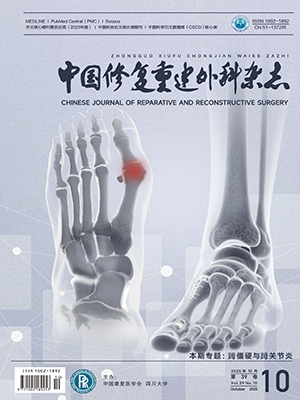Objective To provide a comprehensive summary of the technological evolution, clinical protocols, mechanisms of action, and current research progress of tibial transverse transport (TTT), with the goal of facilitating its standardized application in clinical practice. Methods A systematic review of both domestic and international literature on TTT for the treatment of diabetic foot was conducted. The analysis encompassed technical developments, surgical protocols, combination therapies, regenerative mechanisms, and clinical outcomes. Results Diabetic foot is one of the most severe complications of diabetes mellitus. Conventional treatments show limited efficacy in patients with advanced stages, such as Wagner grade 3/4 or Texas grade C and above. TTT, an evolution of the Ilizarov technique, promotes tissue regeneration through the “tension-stress principle”. The procedure for the treatment of diabetic foot has evolved from an open large cortical window (120 mm×20 mm) to a minimally invasive small window (50 mm×15 mm), with incision length reduced to 10 mm and simplified external fixators. A dual-incision technique (10 mm apart) is now applied at 5 cm distal to the tibial tuberosity. Bone transport typically begins 3-5 days postoperatively at a rate of 1 mm/day, incorporating the “accordion technique” (2 weeks distraction+3 days stabilization+reverse transport). Multicenter studies report a limb salvage rate of 96.1%, wound healing rate of 96.3%, and amputation rate of less than 5%. Combining TTT with vascular reconstruction and antibiotic-loaded bone cement further enhances outcomes. There are also a series of studies on the mechanism of TTT in treating diabetic foot. TTT has been shown to activate the hypoxia-inducible factor 1α-vascular endothelial growth factor/stromal cell-derived factor 1 (HIF-1α-VEGF/SDF-1) signaling pathway to facilitate microcirculatory reconstruction; mobilize immune cells and rebalance macrophage polarization, thereby improving the inflammatory microenvironment; recruit stem cells via chemotaxis to accelerate re-epithelialization; and promote the release of regenerative small extracellular vesicles. Conclusion TTT demonstrates promising clinical potential in the treatment of diabetic foot, particularly in improving limb perfusion and promoting tissue repair. However, the underlying mechanisms have not been fully elucidated. Further in-depth investigations are required. In addition, the current lack of high-quality randomized controlled trials highlights the urgent need for rigorously designed randomized controlled trial to validate the efficacy and safety of this technique.
Citation:
MO Ruiqing, DING Yi, HUA Qikai. Research advances in limb salvage treatment of diabetic foot using tibial transverse transport. Chinese Journal of Reparative and Reconstructive Surgery, 2025, 39(8): 942-949. doi: 10.7507/1002-1892.202505026
Copy
Copyright © the editorial department of Chinese Journal of Reparative and Reconstructive Surgery of West China Medical Publisher. All rights reserved
| 1. |
|
| 2. |
|
| 3. |
|
| 4. |
|
| 5. |
|
| 6. |
|
| 7. |
|
| 8. |
|
| 9. |
|
| 10. |
|
| 11. |
|
| 12. |
|
| 13. |
|
| 14. |
|
| 15. |
武黎黄英. 胫骨横向搬移术治疗重度糖尿病足及其骨髓干细胞动员的机制研究. 南宁: 广西医科大学, 2017.
|
| 16. |
|
| 17. |
|
| 18. |
|
| 19. |
李晓辉. 胫骨横向骨搬移技术治疗严重糖尿病足的临床疗效观察. 太原: 山西医科大学, 2018.
|
| 20. |
|
| 21. |
|
| 22. |
|
| 23. |
|
| 24. |
|
| 25. |
|
| 26. |
|
| 27. |
|
| 28. |
|
| 29. |
|
| 30. |
|
| 31. |
|
| 32. |
|
| 33. |
|
| 34. |
颜玺. 胫骨横向骨搬移促进糖尿病足溃疡愈合的meta分析. 重庆: 重庆医科大学, 2020.
|
| 35. |
|
| 36. |
|
| 37. |
|
| 38. |
|
| 39. |
|
| 40. |
|
| 41. |
连浩宇. 干细胞动员在胫骨横向搬移治疗重度糖尿病足机制中的作用研究. 南宁: 广西医科大学, 2019.
|
| 42. |
|
| 43. |
Kong L, Li Y, Deng Z, et al. Tibial cortex transverse transport regulates Orai1/STIM1-mediated NO release and improve the migration and proliferation of vessels via increasing osteopontin expression. J Orthop Translat, 2024, 45: 107-119.
|
| 44. |
高伟. 重度糖尿病足横向骨搬移疗效与创面再生机制中巨噬细胞及表皮干细胞作用研究. 南宁: 广西医科大学, 2018.
|
| 45. |
|
| 46. |
|
| 47. |
|
| 48. |
|
| 49. |
|
| 50. |
|
| 51. |
|
- 1.
- 2.
- 3.
- 4.
- 5.
- 6.
- 7.
- 8.
- 9.
- 10.
- 11.
- 12.
- 13.
- 14.
- 15. 武黎黄英. 胫骨横向搬移术治疗重度糖尿病足及其骨髓干细胞动员的机制研究. 南宁: 广西医科大学, 2017.
- 16.
- 17.
- 18.
- 19. 李晓辉. 胫骨横向骨搬移技术治疗严重糖尿病足的临床疗效观察. 太原: 山西医科大学, 2018.
- 20.
- 21.
- 22.
- 23.
- 24.
- 25.
- 26.
- 27.
- 28.
- 29.
- 30.
- 31.
- 32.
- 33.
- 34. 颜玺. 胫骨横向骨搬移促进糖尿病足溃疡愈合的meta分析. 重庆: 重庆医科大学, 2020.
- 35.
- 36.
- 37.
- 38.
- 39.
- 40.
- 41. 连浩宇. 干细胞动员在胫骨横向搬移治疗重度糖尿病足机制中的作用研究. 南宁: 广西医科大学, 2019.
- 42.
- 43. Kong L, Li Y, Deng Z, et al. Tibial cortex transverse transport regulates Orai1/STIM1-mediated NO release and improve the migration and proliferation of vessels via increasing osteopontin expression. J Orthop Translat, 2024, 45: 107-119.
- 44. 高伟. 重度糖尿病足横向骨搬移疗效与创面再生机制中巨噬细胞及表皮干细胞作用研究. 南宁: 广西医科大学, 2018.
- 45.
- 46.
- 47.
- 48.
- 49.
- 50.
- 51.




